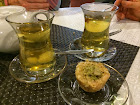For decades, no other country has dominated world news more than Afghanistan. Immediate associations are those of turbaned, bearded men carrying rockets and praying in unison, women in burkas, armed forces and civilian casualties. Politicians use throw-away lines like "failed-state" and "global extremism" when referring to Afghanistan. It has a government undermined by corruption and an economy undercut by a booming narcotic trade which encourages criminality and funds the insurgency. Let's face it, the place is a mess. The country's instability is underlined by the fact that it has had over 20 different flags since it was founded in 1747. They have witnessed many military campaigns - from Alexander the Great (330BC), Genghis Khan and his Mongols (1214) to the more recent Soviet Union invasion (1979), a devastating civil war (1990's) to the US-led War on Terror ( after 9/11 in 2001 and the search for Bin Laden) and many in-between. The Taliban government (1996-2001) managed to destroy everything and anyone that was considered "un-Islamic", from the world's two largest monumental Buddha statues in Bamiyan to out-lawing kite flying.
 left 1963/ right 2001 (note the size of the people at the feet of the Buddha )
left 1963/ right 2001 (note the size of the people at the feet of the Buddha )
Gudiparan bazi or kite flying and fighting is a much loved sport that many have taken to an art-form. From the design and size to the unbreakable tar ( the wire that connects the kite to the leader), kite fighting is a matter of honour and neighbourhood pride. In 2004, the first Afghan president, Hamid Karzai, made it legal to go fly a kite again.
We have already sailed the Spice Route (see blog week 35), and last night we travelled the Silk Route. Landlocked Afghanistan used to be the geocentric location that connected the West to the East, nicknamed the Central Asian Roundabout. It was a major hub of human migration on the Route to the lucrative Silk Trade in China. Kabul (the capital) was a melting pot of cultural fusion, as merchants, pilgrims, monks, soldiers and nomads all paused on their way to the East. For centuries, Afghanistan was the crossroads of many civilizations, and this is reflected in the food.
One tends to forget that Afghanistan used to be a centre of sophistication, but we were reminded of that last night. We met the elegant and gentle Nazira and her husband at their traditional Afghan restaurant, Chopan Charcoal, on Baroona Rd in the inner-city suburb of Milton (named after the poet). Chopan refers to the Hazara tribe in northern Afghanistan. Her family left Afghanistan before the Soviet invasion in 1979, they lived in India for 5 years and then migrated to Australia when Nazira was eight years old. Chopan Charcoal opened its doors 9 years ago, and clearly is a favourite meeting place amongst the Afghan community in Brisbane (only a small percentage of the 36,000 Afghans who live in Australia).
Afghan Cuisine centres around their chief crops: wheat, maize, barley and rice, which is farmed intensely on the mere 12% arable land to feed the 31 million citizens. These basic staples are enhanced by fragrant spices such as mint, saffron, coriander, cardamom and black pepper, together with nuts (pistachios and almonds) and fruits (pomegranates, apricots, oranges and grapes).
The four of us plus Martina shared a combination of entrees, of which my favourite was Bolani (a vegan flatbread with a potato and herb filling). And then the feast began: I ordered the Mantoo (an onion and spiced lamb steamed dumpling served with a tomato based sauce and yoghurt), which was unlike anything I have ever had before and absolutely delicious. Keith had the Quambuli Pulau (flavoured rice with lamb, carrots and sultanas and caramelised onions)- the Afghan national dish, which most of the Afghan patrons seem to order as well. Nielen had the lamb with a delicate korma sauce served with rice. Boetie believes his Chicken Karahi (a one dish meal : Karahi refers to the dish in which this delectable stew of chicken, tomatoes, spices and herbs, topped with fried eggs, is cooked) was by far the most delicious meal of the night ( debatable!). We concluded the meal with a refreshing cup of cardamom and green tea and the Afghan take on baklava. What is not debatable, is that this was a true cultural experience, and the food was different and exciting.....isn't that what this culinary journey is about, after all?
Buried under the doom-and-gloom headlines, there is some positive news. The "facts sharing" ( see blog week one regarding facts) tried to highlight the good-news stories. Martina brought to our attention the amazing work of Alberto Cairo, a Red Cross physio in Kabul who runs the rehabilitation program for those who have lost their limbs, and how he literally gets people back on their feet (the doom-and-gloom bit is that up to 12 people are killed daily by landmines - mostly children). The national animal is the beautiful snow leopard, hiding in the rugged ranges of the Hindu Kush (bad news is that they are nearly extinct, as they are hunted for their precious furs).
Afghanistan has a wealth of mineral deposits: huge veins of iron ore, copper, gold and lithium (used to manufacture batteries for laptops and other mobile devices) which hopefully will kick-start an economy and create work away from the poppy fields (bad news is that the Taliban will fight even harder to gain control over this new found wealth). And lastly, the region of Bamiyan (where the Buddha's were destroyed) has launched a campaign to lure tourists to the region (bad news is that up to now they have had only two visitors).
...and please note: the currency of Afghanistan is the Afghani...the people are Afghans.
...and please note: the currency of Afghanistan is the Afghani...the people are Afghans.
Next week ....El Salvador!













No comments:
Post a Comment